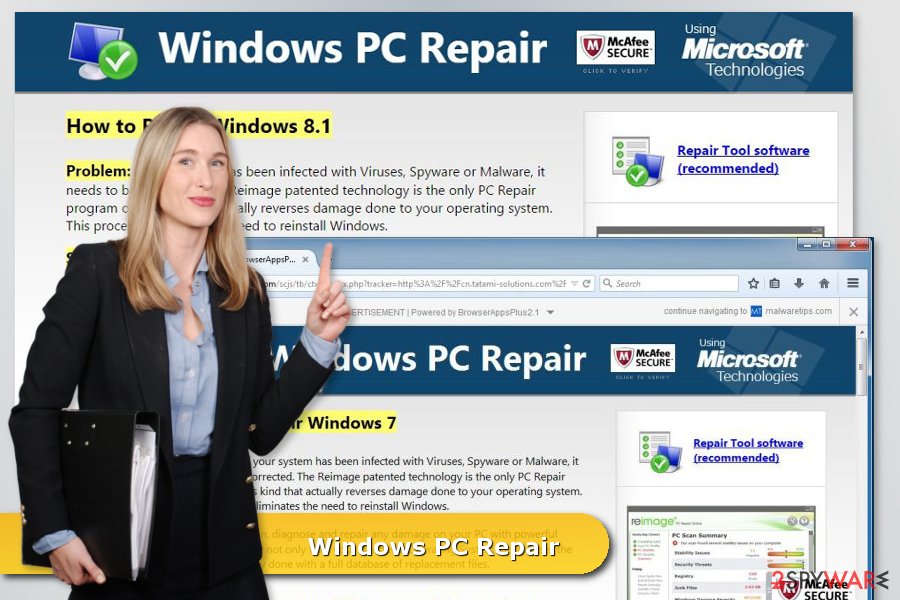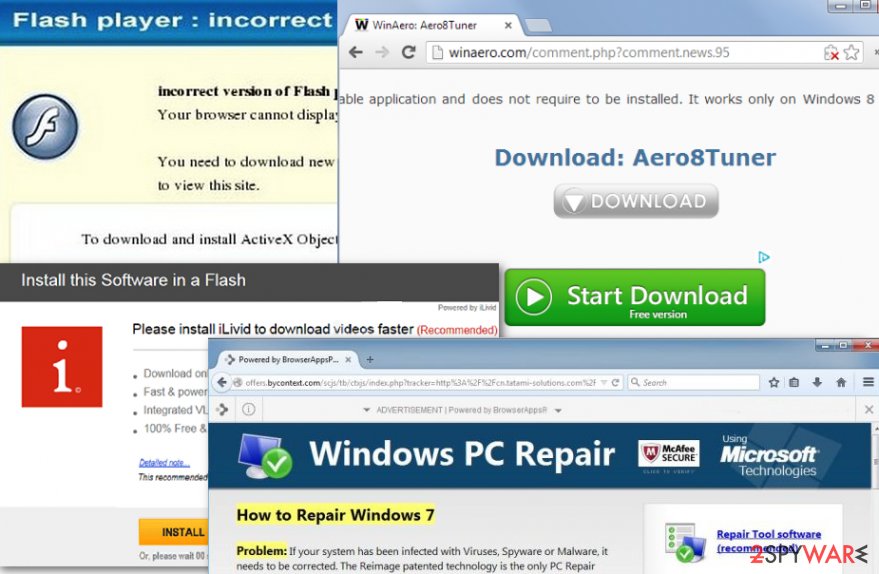“Windows PC Repair” virus (Removal Instructions) - updated Jul 2020
“Windows PC Repair” virus Removal Guide
What is “Windows PC Repair” virus?
Fake “Windows PC Repair” – the adware that triggers fake error pop-ups

“Windows PC Repair” virus mostly affects Windows OS users in the U.S. However, we have received several reports about the same issue on Windows devices in European countries, including Italy, Spain, the Netherlands,[3] and others. This potentially unwanted program (PUP) usually spreads with freeware and shareware.[4] Thus, it can infiltrate the system silently. Once it’s done, it starts to display intrusive ads, pop-ups, and causes other browsing-related problems.
| Name | ”Windows PC Repair” virus |
|---|---|
| Type | Fake messages caused by adware-type infection |
| Issues | These pop-ups trigger promotional material distribution by showing false error alerts. Programs get automatically installed when people trigger the download of a said Repair tool |
| Distribution | These deceptive programs get spread around via misleading sites, other PUPs install then automatically and system applications get added to the software bundles |
| Elimination | ”Windows PC Repair” removal should include proper anti-malware tools |
| Repair | Restore functions and proper performance by running the system scan using FortectIntego |
A few Internet ads here and there do not raise too much concern, but Windows PC Repair ads bring online marketing to another level. And we do not mean that in a positive sense. Thus, allowing it to run on your computer can have some serious consequences. You probably will not lose your files or have your whole operating system rigged since those results are pre-determined.
Nevertheless, this Windows PC Repair virus may sure embitter your browsing experience. Users complain that windows 7 pc repair keeps popping up and they cannot escape this extensive advertising. Indeed, ads will pop up on random sites, disrupting your usual browsing, overlaying the original content of the websites you are visiting and offering you to obtain various products or services.
The message that shows up on those shady scam messages:
Windows PC Repair
System Information: Your machine is currently running: Windows 10
Advance System Care is compatible with your operating system
Download the PC Repair Utility to scan and identify Windows Errors on Windows 10. Update your PC and eliminate potential threats:
Scan your PC for Windows errors with 1 click / Remove Security threats and repair damage caused
Eliminate all Malware from your PC
Some of these offered goods may be purely legitimate, but practice shows that adware developers often include some questionable parties in the list of their affiliates as well. There is always a risk that these parties offer malicious services that can damage your computer, but the Windows PC Repair removal can help to reduce it. Scan your device with a proper anti-malware tool and stop the adware from taking control.
The majority of redirects, and ads are designed to trick people into downloading this questionable windows computer repair tool. However, if you would read one or another window pc repair tool review online, you would find out that this program is useless. It goes without saying that you should not be tricked by this scam and just get rid of the annoying adware. We can assure you that you don’t need help from the questionable Windows 7 pc repair tool.

Ads by Windows PC Repair can be injected on every browser that is installed on your computer at the time of infection. Edge, Firefox, Google Chrome, and Internet Explorer can also start working really slow and often crash due to the extra load from the multiple ads they have to display. Also, system malfunction[5] can occur due to the poor programming of the virus.
But the most dangerous aspect of this adware infection is the Windows PC Repair redirect issue. As we have already pointed out, various software, products, or sites can be promoted in the ads this adware generates. But the problem is that instead of transferring directly to a product-related site, the virus often redirects users through completely different domains which can even be infectious.
So, you can never know if you will not be offered to obtain some corrupt version of a completely legitimate product. Having all these risks in mind, we suggest the users who are seeing these pop-ups to remove Windows PC Repair from their computers without hesitation. Also, do not forget about system alterations and tools like FortectIntego that can find and repair some functions.

Infiltration methods of the adware
If you are wondering how this PUP entered your PC, think about your browsing habits. Downloading freeware and shareware applications or watching some ripped movies once in a while might be the source of your problems. Free applications and peer-to-peer downloads are often bundled with potentially unwanted programs because it is probably the easiest way of spreading them around.
The malware developers are good at hiding these programs in software installers, so the users do not even have to know they agree to install a potentially dangerous program on their computers. But you do not necessarily have to let to malware take over your computer.
You can stop it on the threshold by opting out its installation via the advanced installation settings. When you run the program, choose “Advanced” or “Custom” modes and install your desired programs safely.
“Windows PC Repair” virus removal from Windows
If you cannot escape annoying pop-ups and redirects promoting this questionable tool, you came to the right place. Our team of experts has already taken a good look at this program and has created a tutorial featuring several methods that can be applied for the Windows PC Repair removal.
These methods are described step-by-step at the end of this article. It doesn’t matter if you got infected with windows 10 pc repair virus or you are dealing with adware in Windows 7, 8 or even XP. This PUP can be eliminated using the same methods.
However, if you do not wish to waste your time with this clingy infection which often tends to bounce back to the browser if not deleted properly, have your anti-malware utility to remove it. Select a full system scan option and remove Windows PC Repair once and for all.
You may remove virus damage with a help of FortectIntego. SpyHunter 5Combo Cleaner and Malwarebytes are recommended to detect potentially unwanted programs and viruses with all their files and registry entries that are related to them.
Getting rid of “Windows PC Repair” virus. Follow these steps
Uninstall from Windows
In order to get rid of the adware from Windows OS manually, you have to follow these steps:
Instructions for Windows 10/8 machines:
- Enter Control Panel into Windows search box and hit Enter or click on the search result.
- Under Programs, select Uninstall a program.

- From the list, find the entry of the suspicious program.
- Right-click on the application and select Uninstall.
- If User Account Control shows up, click Yes.
- Wait till uninstallation process is complete and click OK.

If you are Windows 7/XP user, proceed with the following instructions:
- Click on Windows Start > Control Panel located on the right pane (if you are Windows XP user, click on Add/Remove Programs).
- In Control Panel, select Programs > Uninstall a program.

- Pick the unwanted application by clicking on it once.
- At the top, click Uninstall/Change.
- In the confirmation prompt, pick Yes.
- Click OK once the removal process is finished.
Delete from macOS
Remove items from Applications folder:
- From the menu bar, select Go > Applications.
- In the Applications folder, look for all related entries.
- Click on the app and drag it to Trash (or right-click and pick Move to Trash)

To fully remove an unwanted app, you need to access Application Support, LaunchAgents, and LaunchDaemons folders and delete relevant files:
- Select Go > Go to Folder.
- Enter /Library/Application Support and click Go or press Enter.
- In the Application Support folder, look for any dubious entries and then delete them.
- Now enter /Library/LaunchAgents and /Library/LaunchDaemons folders the same way and terminate all the related .plist files.

Remove from Microsoft Edge
If you suffer from “Windows PC Repair” pop-ups, follow these steps to fix Microsoft Edge.
Delete unwanted extensions from MS Edge:
- Select Menu (three horizontal dots at the top-right of the browser window) and pick Extensions.
- From the list, pick the extension and click on the Gear icon.
- Click on Uninstall at the bottom.

Clear cookies and other browser data:
- Click on the Menu (three horizontal dots at the top-right of the browser window) and select Privacy & security.
- Under Clear browsing data, pick Choose what to clear.
- Select everything (apart from passwords, although you might want to include Media licenses as well, if applicable) and click on Clear.

Restore new tab and homepage settings:
- Click the menu icon and choose Settings.
- Then find On startup section.
- Click Disable if you found any suspicious domain.
Reset MS Edge if the above steps did not work:
- Press on Ctrl + Shift + Esc to open Task Manager.
- Click on More details arrow at the bottom of the window.
- Select Details tab.
- Now scroll down and locate every entry with Microsoft Edge name in it. Right-click on each of them and select End Task to stop MS Edge from running.

If this solution failed to help you, you need to use an advanced Edge reset method. Note that you need to backup your data before proceeding.
- Find the following folder on your computer: C:\\Users\\%username%\\AppData\\Local\\Packages\\Microsoft.MicrosoftEdge_8wekyb3d8bbwe.
- Press Ctrl + A on your keyboard to select all folders.
- Right-click on them and pick Delete

- Now right-click on the Start button and pick Windows PowerShell (Admin).
- When the new window opens, copy and paste the following command, and then press Enter:
Get-AppXPackage -AllUsers -Name Microsoft.MicrosoftEdge | Foreach {Add-AppxPackage -DisableDevelopmentMode -Register “$($_.InstallLocation)\\AppXManifest.xml” -Verbose

Instructions for Chromium-based Edge
Delete extensions from MS Edge (Chromium):
- Open Edge and click select Settings > Extensions.
- Delete unwanted extensions by clicking Remove.

Clear cache and site data:
- Click on Menu and go to Settings.
- Select Privacy, search and services.
- Under Clear browsing data, pick Choose what to clear.
- Under Time range, pick All time.
- Select Clear now.

Reset Chromium-based MS Edge:
- Click on Menu and select Settings.
- On the left side, pick Reset settings.
- Select Restore settings to their default values.
- Confirm with Reset.

Remove from Mozilla Firefox (FF)
Remove all suspicious extensions from the Mozilla Firefox and reset the browser as shown below.
Remove dangerous extensions:
- Open Mozilla Firefox browser and click on the Menu (three horizontal lines at the top-right of the window).
- Select Add-ons.
- In here, select unwanted plugin and click Remove.

Reset the homepage:
- Click three horizontal lines at the top right corner to open the menu.
- Choose Options.
- Under Home options, enter your preferred site that will open every time you newly open the Mozilla Firefox.
Clear cookies and site data:
- Click Menu and pick Settings.
- Go to Privacy & Security section.
- Scroll down to locate Cookies and Site Data.
- Click on Clear Data…
- Select Cookies and Site Data, as well as Cached Web Content and press Clear.

Reset Mozilla Firefox
If clearing the browser as explained above did not help, reset Mozilla Firefox:
- Open Mozilla Firefox browser and click the Menu.
- Go to Help and then choose Troubleshooting Information.

- Under Give Firefox a tune up section, click on Refresh Firefox…
- Once the pop-up shows up, confirm the action by pressing on Refresh Firefox.

Remove from Google Chrome
Follow the steps below to uninstall all suspicious components that might be related to Windows PC Repair malware:
Delete malicious extensions from Google Chrome:
- Open Google Chrome, click on the Menu (three vertical dots at the top-right corner) and select More tools > Extensions.
- In the newly opened window, you will see all the installed extensions. Uninstall all the suspicious plugins that might be related to the unwanted program by clicking Remove.

Clear cache and web data from Chrome:
- Click on Menu and pick Settings.
- Under Privacy and security, select Clear browsing data.
- Select Browsing history, Cookies and other site data, as well as Cached images and files.
- Click Clear data.

Change your homepage:
- Click menu and choose Settings.
- Look for a suspicious site in the On startup section.
- Click on Open a specific or set of pages and click on three dots to find the Remove option.
Reset Google Chrome:
If the previous methods did not help you, reset Google Chrome to eliminate all the unwanted components:
- Click on Menu and select Settings.
- In the Settings, scroll down and click Advanced.
- Scroll down and locate Reset and clean up section.
- Now click Restore settings to their original defaults.
- Confirm with Reset settings.

Delete from Safari
Remove unwanted extensions from Safari:
- Click Safari > Preferences…
- In the new window, pick Extensions.
- Select the unwanted extension and select Uninstall.

Clear cookies and other website data from Safari:
- Click Safari > Clear History…
- From the drop-down menu under Clear, pick all history.
- Confirm with Clear History.

Reset Safari if the above-mentioned steps did not help you:
- Click Safari > Preferences…
- Go to Advanced tab.
- Tick the Show Develop menu in menu bar.
- From the menu bar, click Develop, and then select Empty Caches.

After uninstalling this potentially unwanted program (PUP) and fixing each of your web browsers, we recommend you to scan your PC system with a reputable anti-spyware. This will help you to get rid of “Windows PC Repair” registry traces and will also identify related parasites or possible malware infections on your computer. For that you can use our top-rated malware remover: FortectIntego, SpyHunter 5Combo Cleaner or Malwarebytes.
How to prevent from getting adware
Stream videos without limitations, no matter where you are
There are multiple parties that could find out almost anything about you by checking your online activity. While this is highly unlikely, advertisers and tech companies are constantly tracking you online. The first step to privacy should be a secure browser that focuses on tracker reduction to a minimum.
Even if you employ a secure browser, you will not be able to access websites that are restricted due to local government laws or other reasons. In other words, you may not be able to stream Disney+ or US-based Netflix in some countries. To bypass these restrictions, you can employ a powerful Private Internet Access VPN, which provides dedicated servers for torrenting and streaming, not slowing you down in the process.
Data backups are important – recover your lost files
Ransomware is one of the biggest threats to personal data. Once it is executed on a machine, it launches a sophisticated encryption algorithm that locks all your files, although it does not destroy them. The most common misconception is that anti-malware software can return files to their previous states. This is not true, however, and data remains locked after the malicious payload is deleted.
While regular data backups are the only secure method to recover your files after a ransomware attack, tools such as Data Recovery Pro can also be effective and restore at least some of your lost data.
- ^ Margaret Rouse. Scareware. TechTarget. Tech terms dictionary and technology-related blogs network.
- ^ Adware. Wikipedia. The free encyclopedia.
- ^ ZonderVirus. ZonderVirus. Recent cyber security news for Danish computer users.
- ^ Shareware & Freeware. Russ Harvey. Russ Harvey Consulting Computer & Internet Services.
- ^ System malfunction. IBM. The official IBM website.























